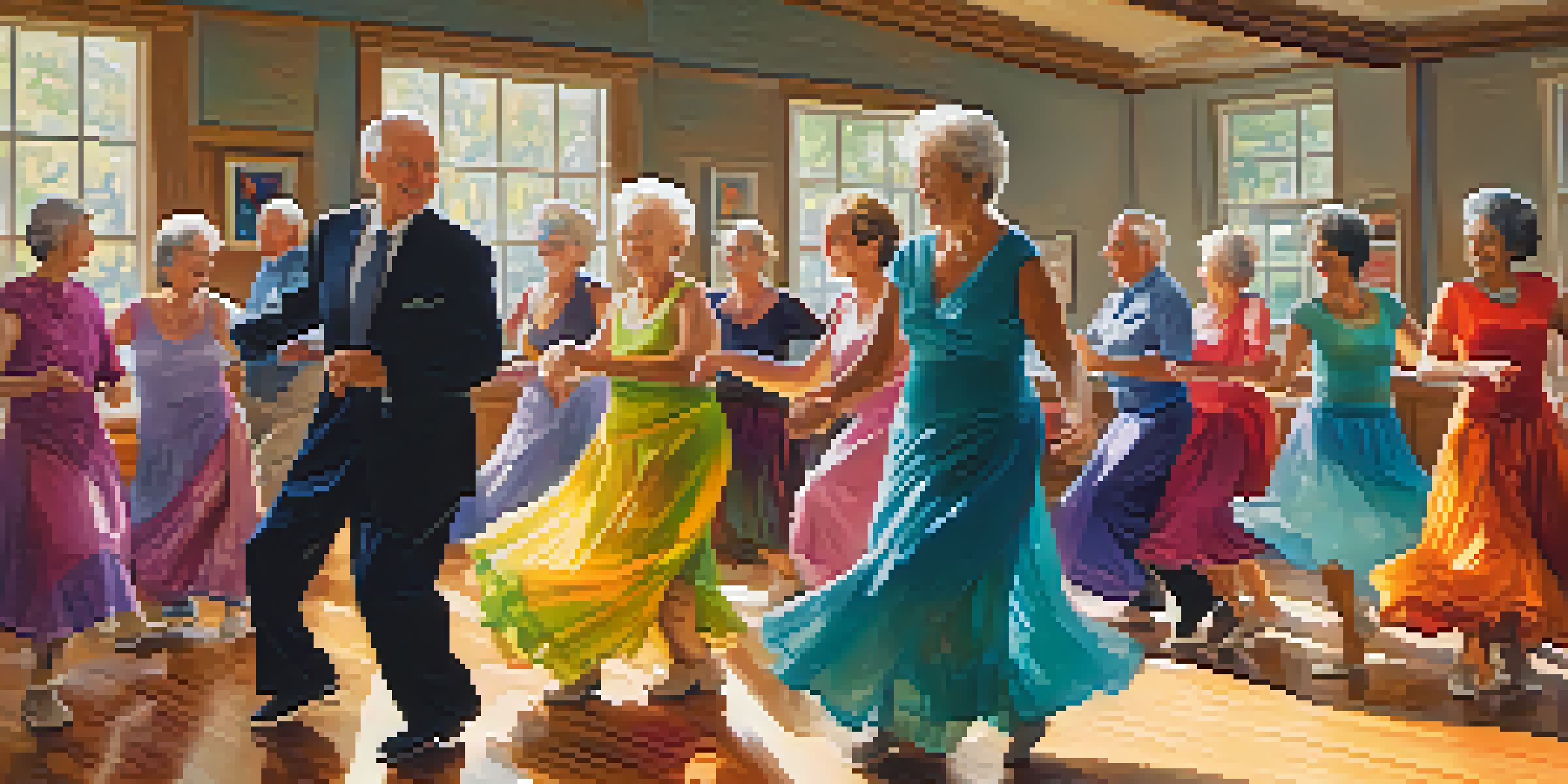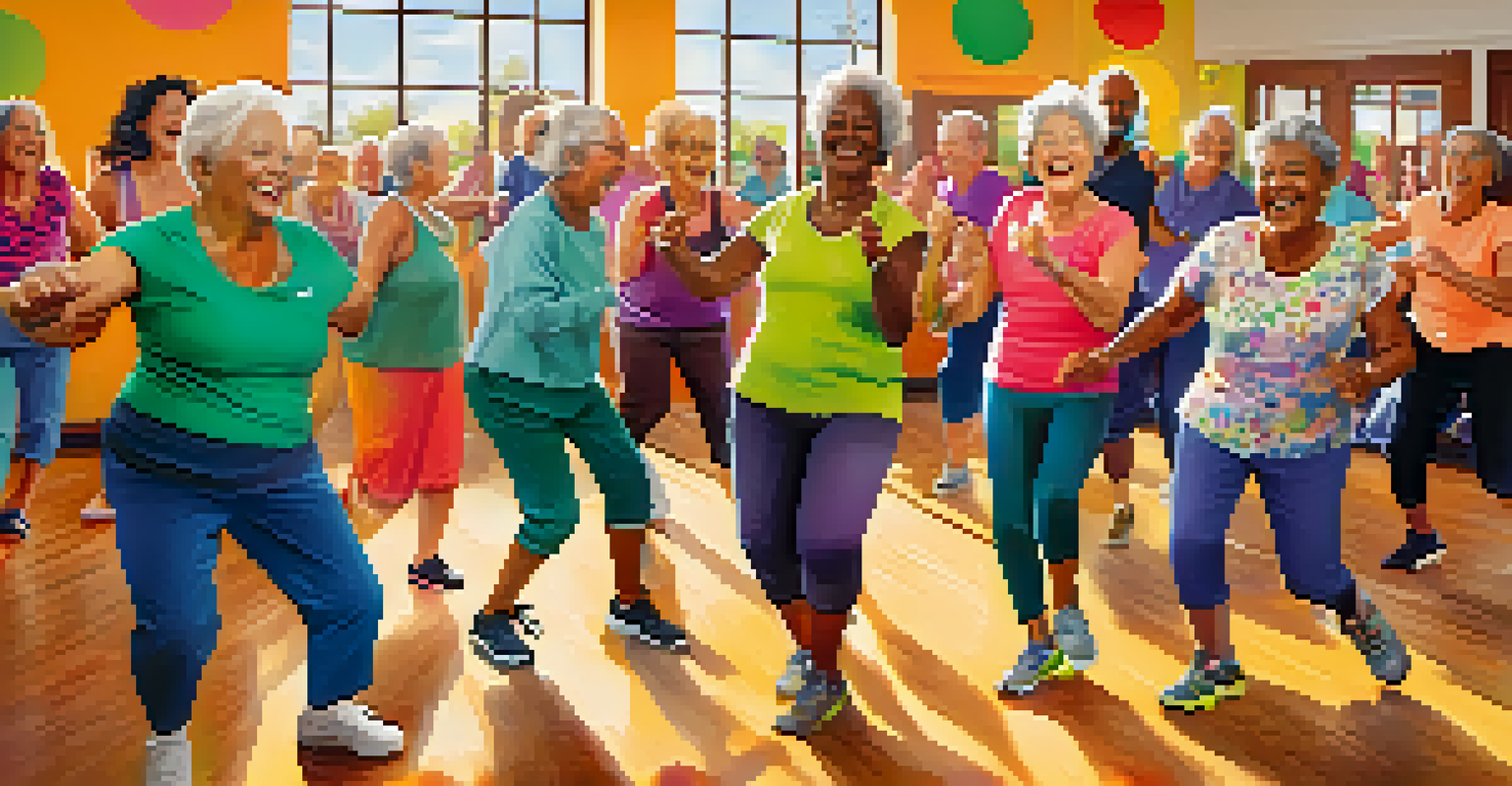Exploring Dance as a Tool for Memory Retention in Seniors

The Connection Between Dance and Memory in Seniors
Dance is not just an art form; it's a powerful tool for enhancing memory, especially in seniors. Engaging in dance stimulates various brain regions responsible for coordination and cognition. As the body moves rhythmically, it creates a unique synergy between physical activity and mental engagement.
Dance is the hidden language of the soul.
Research shows that activities like dance can improve brain health and memory retention in older adults. This is largely due to the complex movements involved, which require participants to remember steps and sequences. Such engagement can help slow cognitive decline, making dance a joyful way to keep the mind sharp.
Moreover, dance encourages social interaction, which is another important factor in cognitive health. When seniors dance together, they not only move their bodies but also connect with others, fostering a sense of community and belonging that further enhances their mental well-being.
How Dance Stimulates Brain Function
When we dance, our brains are hard at work. The coordination required to keep time with music and execute movements activates multiple areas of the brain, including those involved in memory and learning. This multi-tasking nature of dance helps to strengthen neural connections, which can benefit memory retention.

In fact, studies have indicated that the learning of new dance routines can produce positive changes in brain structure. For seniors, this means that each new step or pattern learned not only brings joy but also has lasting effects on their cognitive function. It’s like giving the brain a workout, similar to how physical exercise benefits the body.
Dance Boosts Seniors' Memory
Engaging in dance activates brain regions responsible for memory, helping to enhance cognitive function in older adults.
Additionally, the rhythm and music associated with dance can trigger emotional responses, which are closely linked to memory. When seniors dance to familiar tunes, they often recall memories associated with those songs, further enhancing their cognitive engagement and retention.
Social Benefits of Dancing for Seniors
Dancing is inherently social, allowing seniors to interact and bond over shared experiences. These social connections are vital for mental health, as they help combat loneliness and isolation. Engaging with others in a fun and lively environment encourages seniors to participate actively and positively.
To watch us dance is to hear our hearts speak.
Group dance classes often create a supportive atmosphere where seniors feel comfortable expressing themselves. This camaraderie can make learning new steps less daunting and more enjoyable. It also fosters a sense of accomplishment, which can boost self-esteem and motivation.
Moreover, social dancing often incorporates partner work, which can be particularly beneficial for seniors. It encourages communication and teamwork, helping to strengthen relationships and build new friendships. This social interaction is not only fun but also crucial for maintaining cognitive health.
Types of Dance Suitable for Seniors
There are many types of dance that seniors can enjoy, each offering unique benefits. From gentle styles like ballroom and line dancing to more energetic forms like Zumba, there’s something for everyone. These variations allow seniors to choose a dance that matches their physical abilities and preferences.
For those who may have mobility issues, seated dance classes can provide a fantastic alternative. These classes adapt traditional dance movements to be performed while sitting, ensuring everyone can participate. It’s a great way to stay active without overexerting oneself.
Social Interaction is Key
Dancing fosters social connections that combat loneliness, significantly contributing to mental well-being among seniors.
Additionally, dance styles that include social elements, like swing or salsa, can make the experience even more enjoyable. This not only engages the body but also encourages connection with others, making the dance experience richer and more fulfilling.
Incorporating Dance into Daily Life
Incorporating dance into daily life doesn’t have to be complex or time-consuming. Simple activities like dancing to favorite songs at home can be a great starting point. Even a few minutes a day can help boost mood and memory, making it a delightful addition to any routine.
Seniors can also look for local dance classes or community events that cater to their age group. Many communities offer programs specifically designed for older adults, ensuring a safe and supportive environment. This not only provides structured dance opportunities but also encourages social interaction.
Additionally, family members can join in the fun by organizing dance parties at home. This not only brings joy but also creates cherished memories, reinforcing familial bonds and encouraging seniors to stay active in a familiar and loving setting.
The Role of Music in Dance and Memory
Music plays a crucial role in enhancing the effects of dance on memory retention. Familiar tunes can evoke vivid memories and emotions, serving as powerful triggers for cognitive recall. When seniors dance to music they love, it often sparks joyful recollections from their past.
Moreover, the rhythm of music helps establish patterns that can aid in learning new dance steps. This rhythmic structure can make it easier for seniors to remember sequences, as the music provides a mental anchor for their movements. It's much like how we remember lyrics to songs; the melody helps cement those memories.
Music Enhances Dance Experience
Familiar music not only triggers joyful memories but also aids in learning new dance steps, enriching the overall experience.
Incorporating a variety of musical genres can also keep dance sessions fresh and engaging. From classic hits to contemporary favorites, varying the soundtrack can stimulate different emotional responses and keep seniors eager to participate.
Conclusion: Dance as a Lifelong Memory Tool
In conclusion, dance emerges as a delightful and effective tool for memory retention in seniors. Its multifaceted benefits—ranging from physical engagement to social interaction—make it an excellent choice for enhancing cognitive health. Whether through a structured class or spontaneous dancing at home, the opportunities are plentiful.
Encouraging seniors to dance not only aids in memory retention but also enriches their overall quality of life. It brings joy, promotes physical well-being, and fosters connections with others, creating a holistic approach to mental health.

As we continue to explore innovative ways to support aging gracefully, dance stands out as a vibrant option, reminding us that it’s never too late to move, connect, and flourish.